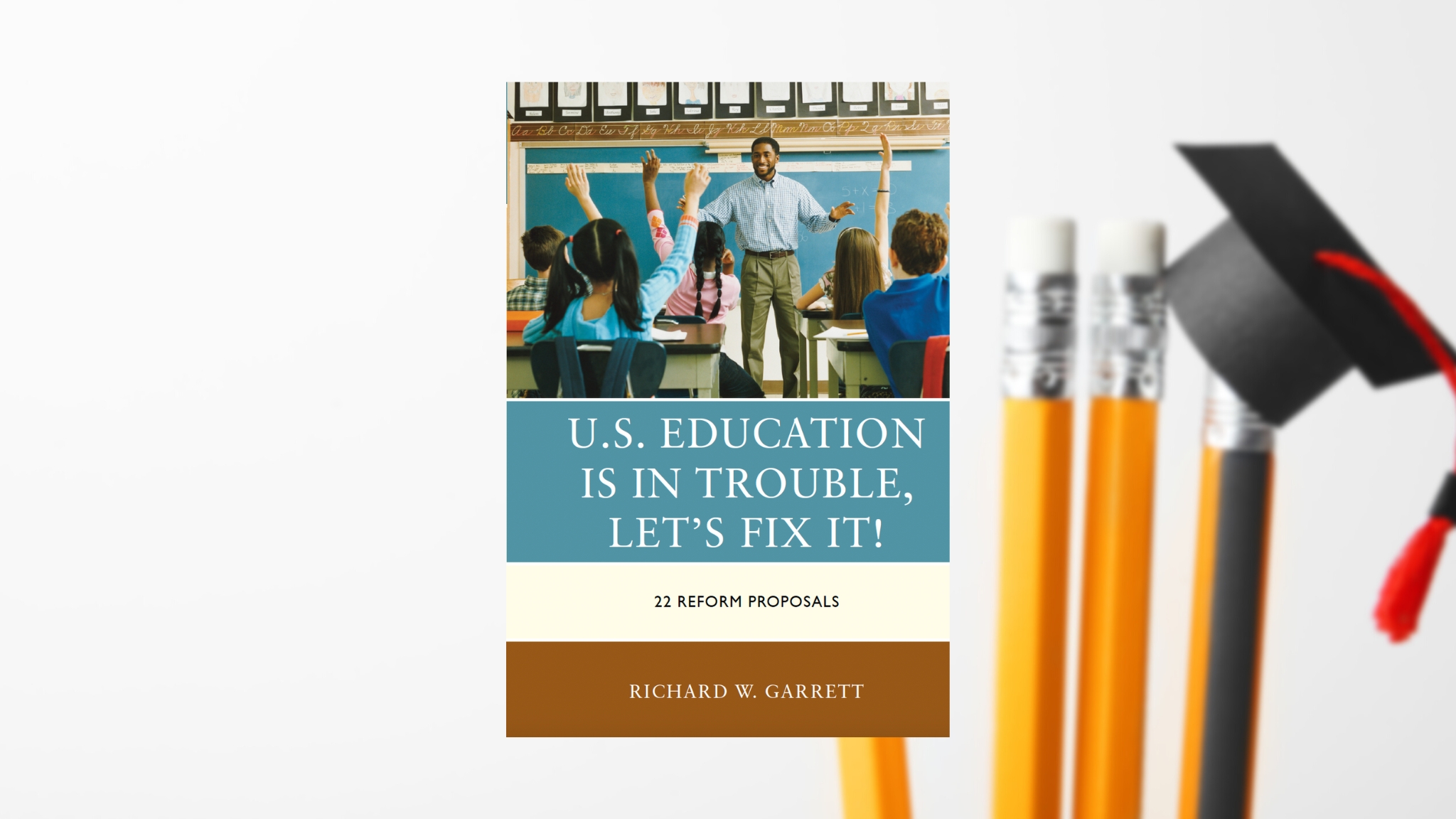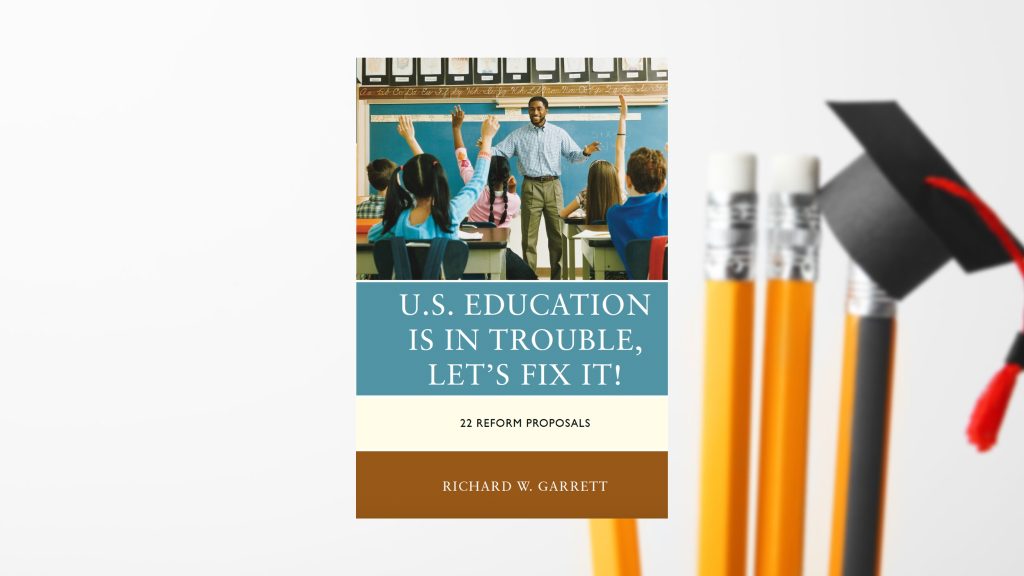
U.S. Education Is in Trouble, Let’s Fix It! 22 Reform Proposals by Richard W. Garrett
What’s it About?
A book about educational reform based on the author’s ten-year expedition to research the U.S. K-12 system to find things in need of improvement. The book covers a wide range of topics such as the performance of American students, classroom discipline and parenting issues.
“We need to regain that relentless focus on getting an education in the face of obstacles, that’s what we need to reclaim, as a community and as a nation … We need to start feeling that hunger again … to fight to educate ourselves and our children like our lives depend upon it, because they do.”
Words spoken a decade ago by Michelle Obama at a commencement speech. Here we are 10 years later, and, according to one crusader engaged in research on educational reform since 2013, the battle rages on — and has a way to go.
On the world stage, the United States is a middle-of-the-pack performer when it comes to academic performance, says Richard W. Garrett, author of U.S. Education Is in Trouble, Let’s Fix It! 22 Reform Proposals (Rowman & Littlefield Publishers). Some of the vital statistics at his disposal are downright scary. “If you knew what I know, you’d be worried too,” he is quick to note.
In this research-laden analysis, Garrett methodically and intricately shares with readers what he does in fact know and why the existing situation is so dire — and aims to offer solutions to fix it, as the title suggests.
It would be too easy to play the blame game — and as Garrett notes, the world doesn’t need another diatribe highlighting everything that’s wrong with our educational system. Unless it helps bring forth a solution.
Four Primary Causes for Education’s Decline
Garrett identifies what he believes are the four primary reasons for the decline of our public school system: parenting issues; irresponsible management by school boards and superintendents; runaway discipline problems; and social promotion (promoting children to the next grade without having them meet the necessary reading requirements).
When it comes to disciplinary matters in the classroom, the effect is paramount. Consider that when a few “bad apple” students disrupt the classroom, it invites a disturbing chain with enormous impact: the teacher has to cut away from the 220 precious minutes of daily teaching time; motivated students are deprived of learning; parents don’t want to take accountability for the child’s misbehavior and in some cases are defiant; administrators are petrified of lawsuits from parents so they cater to them regardless of right and wrong; and teachers become demotivated and question their choice of profession. Taken a step further, the “bad apples” accumulate “followers,” heightening the problem even more.
The parental attitude of “he’s at school; he’s your problem” is not going to take us in the right direction, Garrett laments.
“Lack of discipline and lack of respect are destroying our education system,” writes Garrett. “It drives teachers out of teaching and makes new candidates afraid to enter the field.”
Then there’s the matter of boosting a child’s self-esteem — a noble goal but one that Garrett says has been mishandled. Everyone “gets a trophy” and brings home top grades — an artificial reward system not based on achievement. And it masks the real situation, making it harder to fix. What are the consequences of poor work or failure?
Garrett takes a very granular approach to his topic, going into great detail about the state of our nation when it comes to learning, student proficiency statistics, the plight of teachers, breakdown of the current school day, how schools should be organized, the all-important discipline issues, and much more.
Champion for U.S. Children and Teachers
His analysis is compelling — and frightening.
Garrett’s work is so complete that even though it is loaded with facts, statistics and graphical representations of trends, it is a swift read for anyone — parent, teacher, administrator, some students and any concerned citizen — looking to be enlightened on this all-too-crucial subject. It’s hard to dispute Garrett’s arguments, and it’s encouraging to hear his remedies.
In his final chapter, the author lists “22 Resolutions” that can shape but not necessarily fix once and for all our broken system. Some of his ideas involve recurring themes while others are out of the box.
Unfortunately, 13 pages of ideas are not going to change the system, and Garrett knows it. Yet if he can provide food for thought, based on fact, observation and insight, and if he can get a wider net of people talking, exploring and maybe even acting, then his efforts are not in vain.
Anyone who cares about our youth and cares about our country should add this title to their must-read list.
“This book is a champion for children who want to learn and for teachers who want to teach,” says Garrett. “The goal is an education system that will educate more children, educate them well, and put the United States in the top tier worldwide.”
 About Richard W. Garrett:
About Richard W. Garrett:
Richard W. Garrett has been engaged in research on educational reform since 2013. This is his second major literary effort, his other being The Kids Are Smart Enough, So What’s the Problem? A Businessman’s Perspective on Educational Reform and the Teacher Crisis (Rowman & Littlefield). Another notable effort was an article in the Harvard Business Review, titled “Weighing Risk in Capacity Expansion.”
Garrett is a trained Industrial Engineer, BS and MS (Purdue), and has a PhD in Operations Research (Northwestern University). He has 27 years of business experience with Eli Lilly and Company.
Beginning in 1994, having retired from Lilly, he was an associate clinical professor at the Kelley School of Business, Indiana University, Bloomington, and during the same period he was a partner in a consulting firm. During his 6-1/2 years at IU he won an award for the most Innovative New Course in the MBA program. Learn more at www.elevateteachers.org.

Publish Date: 8/7/2023
Genre: Education, Nonfiction
Author: Richard W. Garrett
Page Count: 188 pages
Publisher: Rowman & Littlefield Publishers
ISBN: 9781475872477

